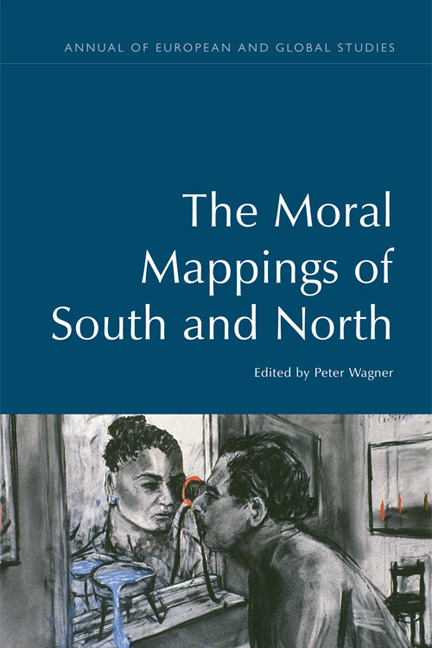Book contents
- Frontmatter
- Contents
- List of Figures
- Notes on the Contributors
- Acknowledgements
- 1 Finding One's Way in Global Social Space
- 2 Does the World Have a Spatio-political Form? Preliminaries
- 3 The BRICS Countries: Time and Space in Moral Narratives of Development
- 4 Russia between East, West and North: Comments on the History of Moral Mapping
- 5 Digging for Class: Thoughts on the Writing of a Global History of Social Distinction
- 6 North–South and the Question of Recognition: A Constellation Saturated with Tensions
- 7 On Spaces and Experiences: Modern Displacements, Interpretations and Universal Claims
- 8 The South as Exile
- Index
6 - North–South and the Question of Recognition: A Constellation Saturated with Tensions
- Frontmatter
- Contents
- List of Figures
- Notes on the Contributors
- Acknowledgements
- 1 Finding One's Way in Global Social Space
- 2 Does the World Have a Spatio-political Form? Preliminaries
- 3 The BRICS Countries: Time and Space in Moral Narratives of Development
- 4 Russia between East, West and North: Comments on the History of Moral Mapping
- 5 Digging for Class: Thoughts on the Writing of a Global History of Social Distinction
- 6 North–South and the Question of Recognition: A Constellation Saturated with Tensions
- 7 On Spaces and Experiences: Modern Displacements, Interpretations and Universal Claims
- 8 The South as Exile
- Index
Summary
IN RECENT TIMES we have witnessed what appears to be the return of a certain expectation in terms of the emancipatory and transformative potential of the South, at an economic level, but also politically and socially (Gray and Gills 2016). The awakening of this interest is due to the trustworthiness demonstrated by cooperation amongst so-called Southern countries, and stems from the new visibility that this has attained within representational frameworks. The re-emergence of a Southern layout based on the controversial Global South category, the SSC acronym (South-South Cooperation) and especially that of BRICS (Brazil, Russia, India, China, South Africa), have built upon a historic promise. This promise was made in the second half of last century, specifically from the 1960s and 1970s onwards, drawing on novel economic and cultural theories. It was aimed at creating innovations that could rearrange the world and was formulated for the first time in the African and Asian Non-Aligned Countries’ Conference in Bandung in 1955, whose principles were the SSC's foundational motto (equality, mutual benefit, respect for sovereignty, non-interference and non-aggression).
In the following decade the history of colonialism that had its origin in the distant sixteenth century was about to end: the process of anti-colonial struggles had – almost entirely – been accomplished in the form of national liberation or by means of the decolonisation process that was achieving its final goals in Africa. ‘Recognising that the peoples of the world ardently desire the end of colonialism in all its manifestations’ was stated – at last – in the United Nations’ Declaration on the Granting of Independence to Colonial Countries and Peoples (UN General Assembly 1960).
Along with the apparent heterogeneity of liberated Southern countries, the factors that were common amongst them were their past of subjugation, an economically dependent present and a future already marked in advance by the challenges of reducing their own developmental differences, as well as those of countries without a colonial past and that had experienced significant economic growth during the 1950s and 1960s. Only thereafter could the geographical contrast start to evolve into something patently geopolitical: thus, the debate about economic development entered the global political agenda and was laid out as the North–South divide (for a complete account of the meaning of this binary opposition, see Pinheiro in this volume).
- Type
- Chapter
- Information
- The Moral Mappings of South and North , pp. 127 - 160Publisher: Edinburgh University PressPrint publication year: 2017

